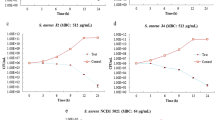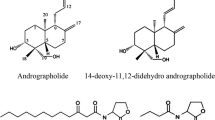Abstract
The present study was aimed to investigate the antibacterial potential and antibiofilm activity of thymoquinone and its mechanism of action. Antibacterial activity of thymoquinone was studied using minimum inhibitory concentration, minimum bactericidal concentration, time-kill assay, and post-antibiotic effect. Thymoquinone exhibited antibacterial activity against both Gram-negative and Gram-positive bacteria. In this study, the minimum inhibitory concentration was found to be in the range of 1.56 to 100 μg/ml. Scanning electron microscopy imaging revealed changes in cell morphology with dents, cell lysis, and reduction in cell size. Live/dead imaging using acridine orange and ethidium bromide confirmed the bactericidal activity as treated bacteria showed selective uptake of ethidium bromide over acridine orange. Cell viability was also studied using HaCaT (human keratinocytes) cell line by MTT assay, and IC90 value was found to be 50 μg/ml. This IC90 value was higher than that of MICbacteria (except for MIC of E. coli), demonstrating that its selectivity is higher towards bacteria than normal human cells. Thymoquinone also showed promising antibiofilm activity against Gram-negative (E. coli and P. aeruginosa) and Gram-positive bacteria (B. subtilis and S. aureus), which was studied by crystal violet assay, CFU method, and SEM. For understanding the mechanism of action of thymoquinone, DiSC3, NPN, and ROS assay was performed. DiSC3 and NPN assay has not shown any membrane damage whereas bacterial cells treated with thymoquinone at MIC showed increased dichlorofluorescin fluorescence, suggesting that the probable mechanism of action of thymoquinone against bacterial cells is due to the production of reactive oxygen species.









Similar content being viewed by others
References
Ahmad A, Husain A, Mujeeb M, Khan SA, Najmi AK, Siddique NA, Damanhouri ZA, Anwar F (2013) A review on therapeutic potential of Nigella sativa: a miracle herb. Asian Pac J Trop Biomed 3(5):337–352. https://doi.org/10.1016/S2221-1691(13)60075-1
Almshawit H, Macreadie I (2017) Fungicidal effect of thymoquinone involves generation of oxidative stress in Candida glabrata. Microbiol Res 195:81–88. https://doi.org/10.1016/j.micres.2016.11.008
Andrade RJ, Tulkens PM (2011) Hepatic safety of antibiotics used in primary care. J Antimicrob Chemother 66(7):1431–1446. https://doi.org/10.1093/jac/dkr159
Barry AL, Craig WA, Nadler H, Reller LB, Sanders CC, Swenson JM (1999) Methods for determining bactericidal activity of antimicrobial agents; approved guideline M 26-A. Clin Lab Stand Inst 19:1–29
Cady NC, McKean KA, Behnke J, Kubec R, Mosier AP, Kasper SH, Burz DS, Musah RA (2012) Inhibition of biofilm formation, quorum sensing and infection in Pseudomonas aeruginosa by natural products-inspired organosulfur compounds. PLoS One 7(6):e38492. https://doi.org/10.1371/journal.pone.0038492
Cai J-Y, Wang Y-Y, Ma K, Hou Y-N, Li J, Yao G-D, Liu W-W, Otkur W, Hayashi T, Itoh K, Tashiro S, Ikejima T (2017) Silibinin protects Staphylococcus aureus from UVC-induced bactericide via enhanced generation of reactive oxygen species. RSC Adv 7(53):33194–33200. https://doi.org/10.1039/C7RA03981F
Chaieb K, Kouidhi B, Jrah H, Mahdouani K, Bakhrouf A (2011) Antibacterial activity of thymoquinone, an active principle of Nigella sativa and its potency to prevent bacterial biofilm formation. BMC Complement Altern Med 11(1):29. https://doi.org/10.1186/1472-6882-11-29
Chalasani N, Fontana RJ, Bonkovsky HL, Watkins PB, Davern T (2008) Clinical advances in liver, pancreas and biliary tract - causes, clinical features, and outcomes from a prospective study of drug-induced liver injury in the united states. Gasteroentrology 135(6):1924–1934. https://doi.org/10.1053/j.gastro.2008.09.011
Chen C, Zhou J, Ji C (2010) Quercetin: a potential drug to reverse multidrug resistance. Life Sci 87(11-12):333–338. https://doi.org/10.1016/j.lfs.2010.07.004
Cowan MM (1999) Plant products as antimicrobial agents. Clin Microbiol Rev 12(4):564–582
Daba MH, Abdel-Rahman MS (1998) Hepatoprotective activity of thymoquinone in isolated rat hepatocytes. Toxicol Lett 95(1):23–29. https://doi.org/10.1016/S0378-4274(98)00012-5
Dosler S, Karaaslan E (2014) Inhibition and destruction of Pseudomonas aeruginosa biofilms by antibiotics and antimicrobial peptides. Peptides 62:32–37. https://doi.org/10.1016/j.peptides.2014.09.021
Dwivedi S, Wahab R, Khan F, Mishra YK, Musarrat J, Al-khedhairy AA (2014) Reactive oxygen species mediated bacterial biofilm inhibition via zinc oxide nanoparticles and their statistical determination. PLoS One 9:1–9
Ghosh C, Manjunath GB, Akkapeddi P, Yarlagadda V, Hoque J, Uppu DSSM, Konai MM, Haldar J (2014) Small molecular antibacterial peptoid mimics: the simpler the better. J Med Chem 57(4):1428–1436. https://doi.org/10.1021/jm401680a
Gurung RL, Lim SN, Khaw AK, Soon JFF, Shenoy K, Mohamed Ali S, Jayapal M, Sethu S, Baskar R, Hande MP (2010) Thymoquinone induces telomere shortening, DNA damage and apoptosis in human glioblastoma cells. PLoS One 5(8):e12124. https://doi.org/10.1371/journal.pone.0012124
Halawani E (2009) Antibacterial activity of thymoquinone and thymohydroquinone of Nigella sativa L. and their interaction with some antibiotics. Adv Biol Res (Rennes) 3:148–152
Hariharan P, Paul-Satyaseela M, Gnanamani A (2016) In vitro profiling of antimethicillin-resistant Staphylococcus aureus activity of thymoquinone against selected type and clinical strains. Lett Appl Microbiol 62(3):283–289. https://doi.org/10.1111/lam.12544
Høiby N, Bjarnsholt T, Givskov M, Molin S, Ciofu O (2010) Antibiotic resistance of bacterial biofilms. Int J Antimicrob Agents 35(4):322–332. https://doi.org/10.1016/j.ijantimicag.2009.12.011
Hosseinzadeh H, Bazzaz BSF, Haghi MM (2007) Antibacterial activity of total extracts and essential oil of Nigella sativa L. seeds in mice. Pharmacol Online 2:429–435
Jaiswal S, Mishra P (2017) Antimicrobial and antibiofilm activity of curcumin-silver nanoparticles with improved stability and selective toxicity to bacteria over mammalian cells. Med Microbiol Immunol 0:1–15
Kokoska L, Havlik J, Valterova I, Sovova H, Sajfrtova M, Jankovska I (2008) Comparison of chemical composition and antibacterial activity of Nigella sativa seed essential oils obtained by different extraction methods. J Food Prot 71(12):2475–2480. https://doi.org/10.4315/0362-028X-71.12.2475
Kundu J, Kim DH, Kundu JK, Chun KS (2014) Thymoquinone induces heme oxygenase-1 expression in HaCaT cells via Nrf2/ARE activation: Akt and AMPKα as upstream targets. Food Chem Toxicol 65:18–26. https://doi.org/10.1016/j.fct.2013.12.015
Mahmoudvand H, Sepahvand A, Jahanbakhsh S, Ezatpour B, Ayatollahi Mousavi SA (2014) Evaluation of antifungal activities of the essential oil and various extracts of Nigella sativa and its main component, thymoquinone against pathogenic dermatophyte strains. J Mycol Med 24(4):e155–e161. https://doi.org/10.1016/j.mycmed.2014.06.048
Mansour MA, Nagi MN, El-Khatib AS, Al-Bekairi AM (2002) Effects of thymoquinone on antioxidant enzyme activities, lipid peroxidation and DT-diaphorase in different tissues of mice: a possible mechanism of action. CBF. Cell Biochem Funct 20(2):143–151. https://doi.org/10.1002/cbf.968
Olajuyigbe OO, Afolayan AJ (2012) In vitro antibacterial and time-kill assessment of crude methanolic stem bark extract of Acacia mearnsii de wild against bacteria in shigellosis. Molecules 17(12):2103–2118. https://doi.org/10.3390/molecules17022103
Palanisamy NK, Ferina N, Amirulhusni AN, Mohd-Zain Z, Hussaini J, Ping LJ, Durairaj R (2014) Antibiofilm properties of chemically synthesized silver nanoparticles found against Pseudomonas aeruginosa. J Nanobiotechnol 12(1):2. https://doi.org/10.1186/1477-3155-12-2
Parbin S, Shilpi A, Kar S, Pradhan N, Sengupta D, Deb M, Rath SK, Patra SK (2016) Insights into the molecular interactions of thymoquinone with histone deacetylase: evaluation of the therapeutic intervention potential against breast cancer. Mol BioSyst 12(1):48–58. https://doi.org/10.1039/C5MB00412H
Rajput S, Kumar BNP, Sarkar S, Das S, Azab B, Santhekadur PK, Das SK, Emdad L, Sarkar D, Fisher PB, Mandal M (2013) Targeted apoptotic effects of thymoquinone and tamoxifen on XIAP mediated Akt regulation in breast cancer. PLoS One 8:1–13
Sahariah P, Sørensen KK, Hjálmarsdóttir MÁ, Sigurjónsson ÓE, Jensen KJ, Másson M, Thygesen MB (2015) Antimicrobial peptide shows enhanced activity and reduced toxicity upon grafting to chitosan polymers. Chem Commun 51:5–8
Sethi G, Ahn KS, Aggarwal BB (2008) Targeting nuclear factor-kappa B activation pathway by thymoquinone: role in suppression of antiapoptotic gene products and enhancement of apoptosis. Mol Cancer Res 6(6):1059–1070. https://doi.org/10.1158/1541-7786.MCR-07-2088
Shoieb AM, Elgayyar M, Dudrick PS, Bell JL, Tithof PK (2003) In vitro inhibition of growth and induction of apoptosis in cancer cell lines by thymoquinone. Int J Oncol 22(1):107–113
Stubbings WJ (2004) Assessment of a microplate method for determining the post-antibiotic effect in Staphylococcus aureus and Escherichia coli. J Antimicrob Chemother 54(1):139–143. https://doi.org/10.1093/jac/dkh275
Suresh TVK, Negi PS, Sankar KU (2010) Antibacterial activity of Nigella sativa L. seed extracts. Br J Pharmacol Toxicol 1:96–100
Teow S-Y, Liew K, Ali SA, Soo-Beng Khoo A, Peh S-C (2016) Antibacterial action of curcumin against Staphylococcus aureus: a brief review. J Trop Med 2016:1–10. https://doi.org/10.1155/2016/2853045
Woo CC, Loo SY, Gee V, Yap CW, Sethi G, Kumar AP, Tan KHB (2011) Anticancer activity of thymoquinone in breast cancer cells: possible involvement of PPAR-γ pathway. Biochem Pharmacol 82(5):464–475. https://doi.org/10.1016/j.bcp.2011.05.030
Yang ST, Shin SY, Hahm KS, Kim JI (2006) Different modes in antibiotic action of tritrpticin analogs, cathelicidin-derived Trp-rich and Pro/Arg-rich peptides. Biochim Biophys Acta Biomembr 1758(10):1580–1586. https://doi.org/10.1016/j.bbamem.2006.06.007
Zhang L, Dhillon P, Yan H, Farmer S, Hancock REW (2000) Interactions of bacterial cationic peptide antibiotics with outer and cytoplasmic membranes of Pseudomonas aeruginosa. Antimicrob Agents Chemother 44(12):3317–3321. https://doi.org/10.1128/AAC.44.12.3317-3321.2000
Zhao L, Wang H, Huo K, Cui L, Zhang W, Ni H, Zhang Y, Wu Z, Chu PK (2011) Antibacterial nano-structured titania coating incorporated with silver nanoparticles. Biomaterials 32(24):5706–5716. https://doi.org/10.1016/j.biomaterials.2011.04.040
Zubair H, Khan HY, Sohail A, Azim S, Ullah MF, Ahmad A, Sarkar FH, Hadi SM (2013) Redox cycling of endogenous copper by thymoquinone leads to ROS-mediated DNA breakage and consequent cell death: putative anticancer mechanism of antioxidants. Cell Death Dis 4(6):e660. https://doi.org/10.1038/cddis.2013.172
Acknowledgements
The work was partially supported by the Ministry of Electronics and Information Technology and Indian Council of Medical Research, Government of India. Surbhi Goel acknowledges Council of Scientific Research (CSIR), Government of India, for providing financial support as JRF and SRF.
Author information
Authors and Affiliations
Corresponding author
Ethics declarations
Ethical statement
This article does not contain any studies with human participants or animals performed by any of the authors.
Conflict of interest
The authors declare that they have no conflicts of interest.
Electronic supplementary material
ESM 1
(PDF 1016 kb)
Rights and permissions
About this article
Cite this article
Goel, S., Mishra, P. Thymoquinone inhibits biofilm formation and has selective antibacterial activity due to ROS generation. Appl Microbiol Biotechnol 102, 1955–1967 (2018). https://doi.org/10.1007/s00253-018-8736-8
Received:
Revised:
Accepted:
Published:
Issue Date:
DOI: https://doi.org/10.1007/s00253-018-8736-8




